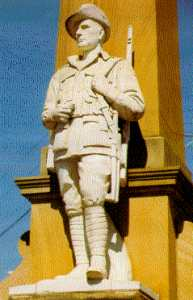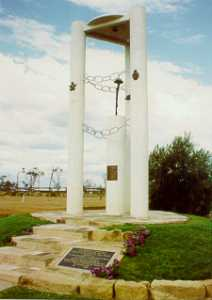War memorials do not praise war, they honour people.

Soldier on the Stone, Beaudesert, Queensland. Image from a photograph by Shirley and Trevor McIvor, Toowoomba.
First Queensland War Memorial. Queensland’s first known war memorial pays tribute to a young school teacher, Lt John (Jack) Lachlan Caskey who left with the Fifth Contingent to fight in the Boer War in South Africa, but was killed in action at Mokari Drift on 27 September 1901. Prior to enlistment he was teaching at Leichhardt Street School, later Brisbane Central, and fellow teachers erected a plaque, which is now in the care of the Clifton Returned Services League (Toowoomba region). Other church and sporting friends erected a memorial in Toowong Cemetery, Brisbane, featuring tennis racquets, cricket bats, a football and a quill. A special plaque is also displayed at Allora State School (Warwick region), so this exceptional young Australian teacher is honoured with three personal memorials.
Boer War (South Africa 1899-1902) Memorials. Following the Boer War the first three soldier statues were erected at Allora, Gatton (Toowoomba region) and in front of the Trades Hall, Brisbane (later moved to ANZAC Square). Unusual Boer War memorials are the kiosk at Charters Towers, the Mafeking Bell at Mount Morgan Scout den, and the Mafeking Tree at Ingham. A small town, Mafeking, was surrounded and under siege by Boer troops but was held for 218 days by British and Australian troops under the command of Colonel Robert Baden Powell before being relieved by troops under Lord Roberts on 17 May 1900. The ‘Relief of Mafeking’ inspired not only the Mafeking Bell and Mafeking Tree, but Lord Baden Powell founded the Boy Scout movement in 1907 based on his Mafeking experiences.
Queensland ‘Firsts’. The first World War 1 memorial in Queensland, situated in Nobby Cemetery, (Toowoomba region), is dedicated to Victor Denton who was killed on Gallipoli in 1915. Pilton, (Toowoomba region), erected the first Soldiers’ Memorial Hall in Australia and Indooroopilly’s ANZAC Memorial Church, (then Methodist, now Uniting), Brisbane, is the only Church to carry the name ANZAC, as the Government then forbade the use of ANZAC in this context. The first Australian Aboriginal war memorial is at Burleigh Heads, (Gold Coast), and the only War Nurses’ Memorial Pavilion is at Bundaberg (Wide Bay Region).
Soldier Statues. Queensland seems to have more soldier statues than other states. Soldier, or Digger memorials are intriguing. Though six were vandalised or demolished in traffic accidents, there are 61 standing across Queensland and all are different. They loosely represent the Light Horse, Infantry and Artillery, with variations in hats, clothing, weapons, physical appearance and hand and leg positions. Two diggers are bronze the others marble or sandstone. Beaudesert memorial represents a relaxed digger with open neck shirt and a pipe in his right hand, and if you check the trigger on his rifle you will notice it is back to front. Most diggers wear a slouch hat, some showing Light Horse emu plumes, two have caps, one a steel helmet, and one a bushman’s hat. The clock under the Cairns (North Queensland) digger has four painted dials set at 4.28am, the time of the ANZACs’ landing on Gallipoli on 25 April 1915. The Windsor State School (Brisbane) memorial is a digger. In 1995 the original Pimpama/Ormeau digger (Gold Coast) was relocated to Miles Historical Village War Museum (Darling Downs) and replaced with a new digger, a smaller version of which was placed on top of the Ravenshoe memorial (Atherton Tableland).

War Memorial at Blackwater, Queensland. Image from a photograph by Shirley and Trevor McIvor, Toowoomba.
Other War Memorials erected included columns, broken columns, pillars, walls, stones, fountains, tapered obelisks, draped obelisks often with crossed rifles which have different positions and different slings. Thirty-one schools have memorials in their grounds including two featuring rifles, one fountain, four diggers, six memorial gates, two Peace Gardens and several Gallipoli pines. Following the Second World War, halls, churches, hospitals, pools, libraries, seats and sporting grounds were popular memorial choices. Many centres added names to the World War 1 memorial, others added Honour Boards in halls and churches. Most schools have Honour Boards which pay tribute to former students who participated in conflicts. More recent Occupation and Peacekeeping Forces are listed on a few memorials and Honour Boards.
Living Tributes in the form of memorial avenues of trees were planted after both World Wars, Roma planting Heroes’ Avenue, with a bottle tree named for each of 93 local young men who did not return from World War 1. In 1995, 154 memorial trees were planted in Gympie to honour former residents, and other centres have plantings with individual memorial plaques. Following fierce fighting at Lone Pine, Gallipoli, cones from the original Lone Pine tree were brought to Australia, and many hundreds of Gallipoli pines honour the fallen.
The most recently planted memorial pine was at Jinibara State School (north of Brisbane). Peace gardens were planted in four centres to celebrate VP day 1995, the 50th Anniversary of the end of World War 2 on 15 August 1945.
Group Tributes. Many centres erected group tributes as well as the central war memorial where ANZAC Day services are held. These special memorials remember the Battle of the Coral Sea; plane crashes; Catalina Flying Boat crews; sailors lost at sea; those lost when the Australian Hospital Ship Centaur was torpedoed by a Japanese submarine in 1943; Gallipoli crack sniper, Billy Sing, who was depicted with a brass bust behind sand bags at Clermont (Central Queensland); former army camp fire places or tributes to groups of soldiers who trained in a district; Z Force commandos and Special Flight airmen; the Sandakan memorial honouring prisoners of war who died on horrific death marches; the Fuzzy Wuzzy Angels who saved many young Australian lives on the Kokoda Trail in New Guinea; and a large piece of volcanic rock from the Kokoda Trail. American service personnel are honoured in many centres, including St Christopher’s Chapel, Nerimbera, (Rockhampton region), as a tribute to their assistance in saving Australia from Japanese invasion in 1942, while Vietnam Veterans’ Place at Kallangur, (Brisbane), honours Vietnam personnel. Townsville’s Heroes’ Walk honours Victoria Cross winners, and an inscription on Townsville’s Battle of the Coral Sea memorial reads: ‘It was our desire to leave a lasting memorial for future generations who may need to be reminded that freedom is often bought at a terrible cost.’
Respect. In 1995 the Australia Remembers project reminded everyone of the men and women who served Australia in time of conflict, and many new tributes were added. Checking war memorials will provide a life long thread of interest, and at the same time appreciation will grow of the tremendous sacrifices made by young Australians in war time, many of whom were as young as 17 years. War memorials in whatever form are in place because young men and women are being honoured for their part in keeping Australia free. They are special and should always be respected. The inscription on the Upper Coomera (Gold Coast) memorial states:
They gave their all. Let you who pass, saluting here their names, see that through you no slur, nor stain, nor shame falls on the land for which they gave their lives - Australia.
For information on all Queensland war memorials:
- Salute the Brave: A Pictorial record of Queensland Memorials by Shirley and Trevor McIvor is available from
USQ Bookshop,
PO Box 58,
Toowoomba Q 4350
(Ph 07 4631 2768) - The CD-ROM Queensland War Memorials and Tributes is available from the authors
Shirley and Trevor McIvor,
27 Maker St,
Toowoomba Q 4350
at $45 postage paid.





